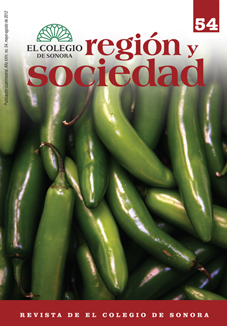 |
 |
 |
 |
 |
 |
 |
 |
 |
 |
 |
 |
Abstract
This article presents the results of a description of chicken meat consumers in the Monterrey metropolitan area, carried out using the CHAID algorithm (Chi-squared Automatic Interaction Detection), which allowed researchers to segment the study variables and perform association tests between them, applying the chi-square distribution. The information was gathered through semi-structured surveys applied to 942 individuals. Among the key findings, income and consumption are features that are positively correlated to preferences in the cut of meat, the type of integrated service offered, and the place of sale. Consumers for the most part have incomes below 20,000 pesos, and they demand meat between six to fifteen times per month.
References
Almanza, Carlos. 2010. El consumo de carne en México. El Economista. http://eleconomista.com.mx/columnas/agro-negocios/2010/02/19/consumo-carne-mexico (19 de febrero).
Barón, S., y D. Phillips. 1994. Attitude Survey Data Reduction Using CHAID: An Example in Shopping Centre Market Research. En Quantitative Methods in Marketing, editado por J. Hooley y K. Hussey, 75-88. Londres: Academic Press.
Bisquerra, R. 1989. Introducción conceptual al análisis multivariable. Un enfoque informático, volúmenes I y II. Barcelona: PPU, S.A.
Bouriche, Johnson y M. Tennanhaus. 1972. Some Segmentation Methods. Metra 7: 407-418.
Breiman, L., J. Friedman, R. Olshen y C. Stone. 1984. Classification and Regresion Trees. Belmont: Wadsworth.
Cellard, J., y B. Labbe. 1967. Le programme ELISSE, presentation et application. Metra 6 (3): 511-520.
Definición, ABC. 2007. Definición de consumidor. http://www.definicionabc.com (11 de octubre de 2010).
Escobar, Modesto. 1998. Las aplicaciones del análisis de segmentación: el procedimiento CHAID. Empiria, Revista de Metodología de las Ciencias Sociales 1: 13-49.
Fowdar, J., Z. Bandar y K. Crockett. 2004. Inducing Fuzzy Decision Trees in Non-deterministic Domains Using CHAID. En Proceedings of the Seventeenth International Florida Artificial Intelligence Research Society Conference, editado por V. Barr y Z. Markou. California: AAAI Press.
García, S. 2005. Caracterización del consumo de carne porcina en la ciudad de Córdoba-Argentina. Facultad de Ciencias Agropecuarias. Universidad Nacional de Córdoba. Argentina: 1-7.
Haidacher, Richard. 1967. An Econometric Study of the Demands for Prune Juice. Tesis doctoral, University of California.
INEGI. 2010. Demografía y población. http://www.inegi.org.mx/prod_serv/contenidos/espanol/bvinegi/productos/integracion/sectorial/biosa/biosa.pdf (2 de febrero de 2010).
Kass, V. 1980. An Explanatory Technique for Investigating Large Quantities of Categorical Data. Applied Statistics 29 (2): 119-127.
Madgison, Jay. 1993. SPSS for Windows CHAID release 6.0. Chicago, SPSS Inc.
Manquilef, Oscar, Horacio Miranda y Berta Schnettler. 2006. Hábitos de consumo de carne bovina en Temuco, IX Región de Chile.Universidad de La Frontera, Facultad de Ciencias Agropecuarias y Forestales. Temuco, Chile. Revista IDESIA 24 (2):15-23.
Mora, F. 2006. Estudio de la red de valor: ejemplo práctico. Colegio de Postgraduados. México: 5.
Muñoz, Manrrubio. 2006. Gestión de la innovación en la red de valor bovinos carne. Centro de Innovación y Desarrollo Rural. Universidad Autónoma Chapingo-Centro de Investigaciones Económicas, Sociales y Tecnológicas de la Agroindustria y la Agricultura Mundial, México.
Quinlan, J. 1993. Programs for Machine Learning. California: Morgan Kaufmann Publishers.
Sanz, Eva y Ana Ponce. 2010. Claves en la aplicación del algoritmo CHAID. Un estudio del ocio físico deportivo universitario. Revista de Psicología del Deporte 19 (2): 319-333.
Schnettler, Berta, Roberto Silva y Néstor Sepúlveda. 2008. Consumo de carne en el sur de Chile y su relación con las características sociodemográficas de los consumidores. Revista Chilena de Nutrición 35 (1): 262-271.
Sonquist, J., y J. Morgan. 1964. The Detection of Interaction Effects. Monographic No. 35. The University of Michigan: Survey Research Center, Institute for Social Research.
Tansini, Rubén. 2003. El consumidor. En Economía para no economistas, 33-42. Departamento de Economía, Universidad de la República, Montevideo Uruguay.
Téllez, Ricardo. 2011. Caracterización del consumidor de carne bovina en la zona metropolitana del valle de México. Tesis de maestría en ciencias socioeconómica estadística e informática, Colegio de Postgraduados.
Vilaboa, Julio, Pablo Díaz, Octavio Ruiz, Diego Platas, Sergio González y Francisco Juárez. 2009. Patrones de consumo de carne bovina en la región del Papaloapan, Veracruz, México. Revista Agricultura, Sociedad y Desarrollo 6 (2): 145-159.
Open access policy
The authors who publish in región y sociedad accept the following conditions:
In accordance with the copyright laws, región y sociedad recognizes and respects the authors’ moral rights, as well as the ownership of property rights, which will be transferred to the journal to disseminate the articles in open access. región y sociedad does not charge the authors for submitting and processing articles for publication.
All the texts published by región y sociedad —with no exception— are distributed under a Creative Commons license 4.0 Attribution – Noncommercial (CC BY-NC 4.0 International), which allows third parties to use the publication as long as they mention the works’ authorship and the first publication in this journal.
The authors can enter into independent and additional contractual agreements for the nonexclusive distribution of the version of the article published in región y sociedad (for instance include it into an institutional repository or publish it in a book) as long as they clearly indicate that the work was published for the first time in región y sociedad.
For all the above, the author(s) must send the Letter of transfer of property rights of the first publication duly filled in and signed by the author(s). This letter can be sent by e-mail as a PDF to: region@colson.edu.mx






